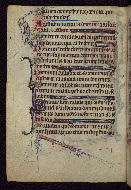Miscellaneous additions:
Repair:
Occasionally during this process, the parchment would tear or expose a hole in the animal skin. In this event, repairs had to be made. Holes in manuscripts were frequently repaired with a needle and thread, and scribes or repairmen would either sew the hole together, stitching a tight seam across the gap, or add another piece of parchment to the blemish in order to cover it up. Holes that occurred in the parchment pre-transcription were often ignored, and scribes would simply skip them when writing. If the hole occurred after transcription or during another stage of the process, however, the repairs made included an attempt at correcting the affected text in order to maintain a cohesive narrative.
Markings:
Most medieval manuscripts contain some sort of extratextual marking, either lingering in the margins or floating interlinearly on the page. These markings can mean a variety of things, and could have been added at any time after the creation of the manuscript, but in their Introduction to Manuscript Studies Graham and Clemens focus on the ones most likely to be encountered by the modern manuscript reader.
- Finding aids: designed to help readers keep their place in a manuscript, finding aids can take the form of a leather string, finger tabs cut from the parchment itself, or an object attached to the page able to be seen when the book is closed. Liturgical books were most in need of finding aids in order to help the celebrant "find his place quickly and easily." The most notable finding aid is the manicula: a drawing of a hand with the index finger outstretched to highlight a significant passage.
- Line fillers: these are aesthetic additions to a text in order to ensure that the margins of the book remain straight, even when the text itself may end far from the margin in question.
- Pen trials: after the cutting of a new quill (or reed), the scribe would generally make a few marks to ensure the pen was cut correctly before diving into transcription.
- Sketches: before embarking on the actual illuminated letter or illustration, artisans would sometimes sketch rough drafts in the margins of a text. While many of these were erased or covered after the true drawing was completed, they are sometimes still visible in the text margins.
To the left is an example of a text with two maniculae pointing out important passages; to the right, an example of text with ornate line fillers. Below are two examples of manuscript leaves that have been repaired; on the left is an example of a hole sewn together; on the right, an example of a page that was torn in half with the addition of new parchment to complete it.








